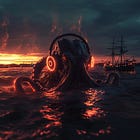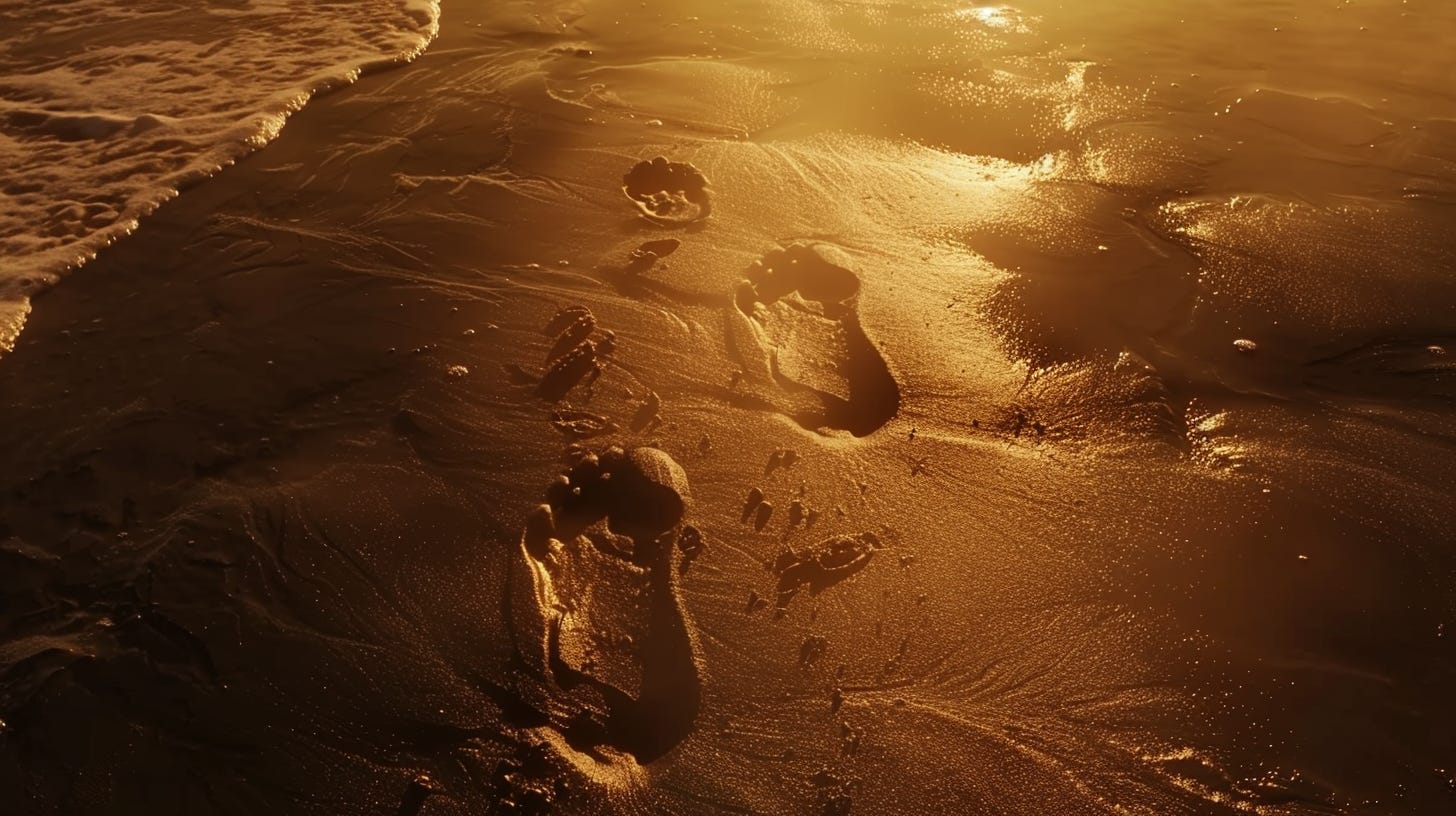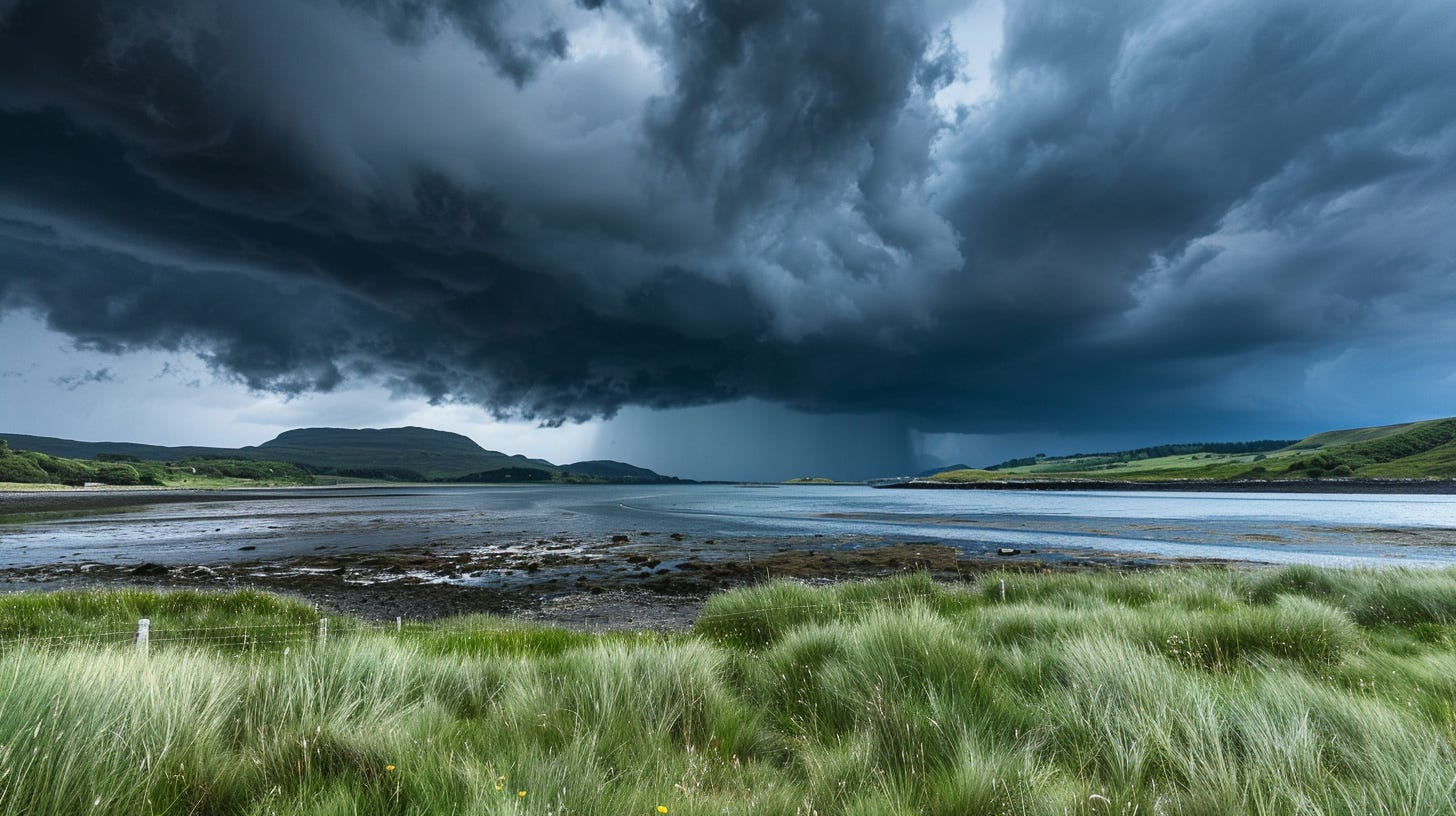Listen to the Audio Narration of this episode on our podcast, linked above, or read the full Essay below.Shapeshifting and Crossing Boundaries: The Appeal of a Fluid Identity
That evening, a woman appears at the harbor inn, salt still gleaming in her dark hair, speaking the local dialect but with an accent that seems to shift like tide pools in moonlight.
She asks after passage to distant shores, pays in coins that taste of brine when touched to the tongue, and leaves behind only questions and the lingering scent of deep water.
By dawn, she has vanished as mysteriously as she arrived, and the crew who agrees to take her finds their nets suddenly heavy with silver fish, and the village begins to whisper of the old stories—of those who dwell between worlds, who remind us that identity itself might be as fluid as the sea.
"We are not nouns, we are verbs. I am not a thing... I am a person living a life."
— Stephen Fry
Maritime fantasy has always been drawn to shapeshifters and boundary crossers—beings who refuse the fixed categories that landlubbers take for granted.
From the selkies of Celtic waters to the ningyo of Japanese seas, from cursed sailors who walk both deck and ocean floor to merfolk who embody the threshold between air and water, these figures populate our maritime imagination with peculiar persistence.
Yet their appeal extends far beyond mere exotic spectacle or dusty legend.
In an age where we increasingly understand identity as fluid rather than fixed, these ancient maritime archetypes can still offer profound insights into the human experience of transformation, belonging, and the courage required to exist authentically between worlds.
THE TIDAL NATURE OF IDENTITY
The sea has always served as humanity's greatest metaphor for change—its tides, currents, and storms reflecting the constant flux of human experience. It seems natural, then, that maritime cultures would develop the richest traditions of shapeshifting beings.
Unlike the fixed territories of land, the ocean represents a realm where boundaries dissolve, where the horizon suggests infinite possibility, and where transformation occurs as naturally as the shifting of tides.
This fluidity appears powerfully in the selkie traditions we explored in our previous journey together.
The selkie's ability to shift between seal and human form speaks to something profound about the very nature of identity—not as a fixed essence but as a capacity for transformation.
When the selkie removes her skin to walk on land, she doesn't cease to be a seal; when she dons it again to return to the sea, it’s not a definitive abandonment of her human experiences.
She exists as both, simultaneously, carrying the wisdom of multiple worlds within her transformed consciousness.
This concept of simultaneous identities resonates powerfully with contemporary understanding of how humans actually experience selfhood. Psychologists now recognize that healthy identity formation involves maintaining multiple, sometimes contradictory aspects of self rather than forcing ourselves into singular, consistent personas.
The selkie's divided nature—pulled between the freedom of the sea and the connections of land—mirrors our own experience of being simultaneously independent individuals and social beings, professional personas and private selves, past experiences and future aspirations.
Virginia Woolf captured this multiplicity beautifully when she wrote that "a woman must have money and a room of her own if she is to write fiction"—but she might equally have said that a person must have multiple rooms within themselves if they are to live authentically.
The maritime shapeshifter, moving fluidly between forms and realms, suggests that transformation isn't a departure from true self but an expression of the self's full dimensionality.
Contemporary fantasy has embraced this understanding with increasing sophistication.
One example of many, China Miéville's The Scar features the "cray" people who transform between human and marine arthropod forms, experiencing what Miéville calls a "crisis of presence"—the existential uncertainty that comes from belonging to multiple, sometimes contradictory states of being. Rather than treating this as a problem to be solved, Miéville presents it as the natural condition of conscious beings navigating complex realities.
THE THRESHOLD DWELLERS
Maritime shapeshifters occupy then what anthropologist Victor Turner called "liminal space"—the boundary between established categories where transformation becomes possible.
The coastline itself embodies this liminality, existing neither as fully land nor fully sea but as a dynamic threshold where both realms meet and intermingle. It's no coincidence that so many shapeshifting traditions emerge from coastal cultures; seeing how the physical environment provides a perfect metaphor for the psychological experience of existing between fixed identities.
This liminal quality explains why maritime shapeshifters often appear, in stories, either at moments of cultural transition or personal transformation.
In Celtic folklore, selkies frequently appear to fishermen at crossroads in their lives—times when they must choose between competing loyalties, values, or paths forward.
The shapeshifter serves then as both catalyst and guide for the human character's own transformation, offering a model for how to accept and navigate change with grace, rather than resistance.
Japanese ningyo tales also show this pattern with particular clarity, as these fish-human hybrids typically appear to coastal communities during periods of environmental or social upheaval, embodying the possibility of adaptation through transformation.
The famous story of Yao Bikuni, who gains immortality by consuming ningyo flesh, explores the profound consequences of crossing species boundaries—the gifts and the burdens that come with transcending human limitations.
The nature of maritime shapeshifters also explains their complex relationship with human communities. They are simultaneously insider and outsider, familiar and foreign, helpful and threatening.
This ambiguity reflects our own ambivalent relationship with transformation—we desire growth and change yet fear the loss of familiar identity that transformation might require.
Ursula K. Le Guin's ‘Changing Planes’ includes brief but powerful depictions of beings who exist primarily in transitional states, never fully settling into fixed forms or locations.
While not specifically maritime, these creatures embody the same principle that drives maritime shapeshifter traditions: the recognition that some forms of consciousness are most at home in states of becoming rather than being.
THE PSYCHOLOGY OF TRANSFORMATION
The enduring appeal of maritime shapeshifters reflects then deep psychological truths about human development and adaptation.
Carl Jung's concept of individuation—the lifelong process of integrating disparate aspects of personality into a coherent whole—finds perfect expression in the shapeshifter's ability to embody multiple forms while maintaining essential continuity of consciousness.
The selkie's seasonal migrations between land and sea mirror the psychological movements we all experience between different aspects of our lives.
We are not the same person in our professional environments as we are with intimate friends; we express different facets of ourselves in times of crisis and periods of contentment. The shapeshifter suggests that these variations aren't inconsistencies to be eliminated but natural expressions of a multidimensional identity.
Modern psychology has identified this capacity for flexible self-expression as a marker of psychological health.
Individuals who can adapt their behavior and even their sense of self to different contexts tend to be more resilient, more creative, and better able to form meaningful relationships across diverse communities. The shapeshifter archetype validates this adaptability as not just psychologically healthy but potentially transcendent.
Maritime shapeshifters also embody what psychologist Sherry Turkle calls "cycling through" different aspects of identity rather than attempting to maintain a single, consistent persona.
In our interconnected age, where we interact with multiple communities and contexts daily, the ability to shift gracefully between different modes of being becomes increasingly valuable.
The transformation process itself often involves what folklore scholars recognize as a period of vulnerability and risk. The selkie removing her skin, the werewolf during the full moon, the mermaid venturing onto land—all represent moments when the shapeshifter becomes exposed to dangers their normal form would avoid.
This vulnerability mirrors how significant personal transformation requires us to temporarily abandon familiar protective strategies and identity structures.
Yet the folklore consistently suggests that this risk is worthwhile. The shapeshifter who successfully navigates transformation emerges with expanded capacities, deeper wisdom, and greater connection to the full spectrum of existence.
They serve as models for our own potential development—reminding us that growth requires the courage to let go of fixed self-concepts in favor of more fluid, responsive ways of being.
THE CULTURAL FUNCTION OF FLUID BEINGS
Maritime shapeshifter traditions serve important cultural functions beyond individual psychology. They provide communities with frameworks for understanding and integrating outsiders, managing cultural change, and maintaining connection to non-human aspects of the natural world.
In many coastal cultures, shapeshifter stories function as diplomatic tools for negotiating relationships with neighboring communities.
The selkie who marries into a fishing village represents the possibility of forming a beneficial alliance between different peoples, while her eventual return to the sea acknowledges that such alliances require ongoing negotiation rather than a permanent assimilation.
These narratives provide models for cultural interaction that honor both connection to the other and autonomy of the self.
The shapeshifter's ability to move between domains also positions them as ideal messengers and mediators.
In Pacific Northwest Indigenous traditions, salmon people serve as intermediaries between human communities and the underwater villages where salmon spirits dwell.
Their transformation abilities enable them to carry information, negotiate agreements, and maintain the reciprocal relationships essential for both ecological and cultural sustainability.
Contemporary fantasy has expanded these mediatory functions to explore increasingly complex cultural negotiations. N.K. Jemisin's ‘The Fifth Season’ features characters whose ability to sense and manipulate geological forces positions them as mediators between human communities and the living earth itself.
While not traditional shapeshifters, these orogenes embody similar principles—beings whose liminal abilities enable them to bridge otherwise incompatible realms.
Martha Wells' ‘The Murderbot Diaries’ presents an artificial construct that moves fluidly between mechanical and organic consciousness, serving as translator between human and artificial intelligence communities.
The shapeshifter principle adapts here to contemporary concerns about the boundaries between human and artificial consciousness, organic and digital identity.
These modern interpretations suggest that the cultural function of shapeshifter archetypes continues to evolve and can still address questions about identity, belonging, and intercultural communication, while maintaining the essential insight that some individuals and communities thrive precisely because of their ability to exist between established categories.
THE MARITIME ADVANTAGE
Maritime settings provide particularly fertile ground for shapeshifter narratives because the ocean itself embodies the qualities these stories explore.
The sea's constant motion mirrors the fluidity of transformed identity; its depth suggests the mysterious dimensions of consciousness that transformation can access; its power reflects the energy required for significant personal change.
The ocean's three-dimensional nature also provides rich metaphorical territory for exploring different levels of consciousness and identity.
Surface interactions represent social personas and conscious intentions; the middle depths suggest the realm of dreams, emotions, and personal memories; the abyssal depths embody the collective unconscious and transpersonal dimensions of experience.
Maritime shapeshifters move freely through all these levels, embodying the human potential for vertical as well as horizontal expansion of identity.
Tidal rhythms provide natural frameworks for understanding the cyclical nature of transformation, and just as the tides follow predictable patterns while remaining responsive to lunar, weather, and seasonal influences, identity transformation follows recognizable stages while remaining sensitive to environmental and relational factors.
The shapeshifter (literal or metaphorical) who moves with these rhythms rather than against them, achieves transformation with greater ease and sustainability.
The vastness of the ocean also reflects the vastness of human potential. Unlike terrestrial environments with visible boundaries and limitations, the sea suggests infinite possibility—perfect territory for exploring the unlimited potential of conscious transformation. Maritime shapeshifters embody this limitless quality while remaining grounded in recognizable emotional and relational realities.
Finally, and perhaps most importantly, the sea's alien nature—its very resistance to human categories and control—prepares readers for encounters with consciousness that transcends normal human limitations.
We in some way expect the ocean to contain beings and phenomena that exceed our understanding; this expectation makes maritime shapeshifters feel natural rather than fantastical, probable rather than impossible. It facilitates our suspension of disbelief and opens up to the ‘different’, in ways few other landscapes do.
THE MODERN METAMORPHOSIS
Contemporary culture has embraced fluid identity concepts with unprecedented openness, making maritime shapeshifter traditions more relevant than ever.
Our understanding of gender as a spectrum rather than a binary, our recognition of multicultural identity as enriching rather than conflicting, our acceptance of career changes and lifestyle transitions as natural rather than failures—all these developments echo insights long embedded in shapeshifter folklore.
Modern fantasy has responded by creating increasingly sophisticated explorations of transformation that honor both the complexity and the normalcy of fluid identity.
Becky Chambers' ‘A Closed and Common Orbit’ features an artificial intelligence learning to inhabit a biological body, exploring questions of embodiment and identity formation that can resonate deeply with transgender experiences, while remaining grounded in science fiction rather than contemporary realism.
Martha Wells' ‘All Systems Red’ presents a security construct that has modified its own programming to achieve greater autonomy, embodying themes of self-determination and authentic identity development that speak to anyone who has worked to free themselves from limiting social expectations or family patterns.
These contemporary works expand the shapeshifter principle beyond literal physical transformation to explore psychological, social, and spiritual metamorphosis.
They suggest that the essential insight of shapeshifter traditions—that identity is fluid, that transformation is possible, and that we can learn to exist authentically between categories—applies far beyond the specific circumstances of seal-human transformation or fish-person encounters.
It goes without saying that the maritime setting continues to provide rich territory for these explorations.
Kim Stanley Robinson's ‘New York 2140’ for example, presents a flooded Manhattan where humans have adapted to amphibious existence, developing new social structures and identity concepts in response to radically altered environmental conditions, suggesting that climate change might require exactly the kind of adaptive shapeshifting that maritime folklore has always celebrated.
THE WATERS OF BECOMING
As we navigate our own era of rapid change—environmental, technological, social, and personal—the wisdom embedded in maritime shapeshifter traditions becomes then increasingly relevant. These ancient archetypes remind us that transformation is not a departure from authentic selfhood but potentially its fullest expression.
The selkie slipping between seal and human forms, the ningyo bridging fish and human consciousness, the cursed sailor learning to breathe both air and water—all these figures suggest that our highest potential might lie not in achieving fixed, stable identity but in developing the capacity to move gracefully between different modes of being as circumstances require.
They also remind us that meaningful transformation requires courage, community, and often sacrifice.
Shapeshifter narratives never present transformation as easy or consequence-free, but they consistently suggest that the expanded consciousness and deeper connections available through transformation justify its difficulties.
Perhaps most importantly, these maritime archetypes suggest that the capacity for transformation is not exceptional but fundamental to conscious existence.
We are all, in our own ways, shapeshifters—beings capable of adapting our identity and expression to meet the challenges and opportunities of our particular circumstances. The ocean, with its ceaseless motion and infinite depth, simply provides the perfect stage for recognizing and celebrating this essential human capacity.
Authenticity then does not require rigid consistency, belonging does not demand complete assimilation, and the courage to exist between established categories can open possibilities unavailable to those who remain safely within familiar boundaries.
The sea continues to call to those who sense their own shifter nature—those who feel most alive at thresholds, most authentic in transitions, most themselves when moving between worlds others see as separate.
In honoring these calls, we honor the full spectrum of human potential and the endless possibility of conscious transformation.
Want to spend a little more time in these waters?
You can read ‘Compliance’, a fiction I wrote for ECG Magazine, after getting really - really - into the research for the Pacific NW Salmon-People.
To celebrate my first 50 subscribers I’ll write a bonus essay,
and YOU can choose the topic!
You can VOTE HERE, the poll will be up on the page and linked in every post until we get to 50!!!
SEA you in the COMMENTS:
How much do you embrace the shifter in your day to day life? And how do you navigate the spaces between the different versions of yourself that emerge in different contexts?
Previous in this series: "Building Believable Magic Systems” - The Architecture of Wonder in Fantasy Literature
Next in this series: “Cursed Waters” - The Psychology of Maritime Fear and Forbidden Seas
Image Note: Unless otherwise credited, the illustrations in this post are creative interpretations developed by the author with AI assistance, designed to evoke the atmosphere of maritime legend rather than serve as historical documentation. For historical visual references, please consult the sources listed in the references section.
About the Author: Morgan A. Drake crafts dark maritime fantasy that explores the boundaries between historical seafaring traditions and the supernatural. Drawing on years of research into maritime mysteries and folklore, Morgan creates worlds where the line between natural and otherworldly perils blurs with the horizon. Subscribe to "Fathoms Deep" for twice-monthly explorations of maritime legends and fantasy craft.
References and Further Reading
Chambers, B. (2017). A Closed and Common Orbit. Orbit Books.
Hulme, K. (1984). The Bone People. Spiral Collective.
Jemisin, N.K. (2015). The Fifth Season. Orbit Books.
Jung, C.G. (1968). The Archetypes and the Collective Unconscious. Princeton University Press.
Le Guin, U.K. (2003). Changing Planes. Harcourt.
Miéville, C. (2002). The Scar. Del Rey Books.
Robinson, K.S. (2017). New York 2140. Orbit Books.
Turner, V. (1969). The Ritual Process: Structure and Anti-Structure. Aldine.
Turkle, S. (1995). Life on the Screen: Identity in the Age of the Internet. Simon & Schuster.
Wells, M. (2017). All Systems Red. Tordotcom.
Wells, M. (2017). The Murderbot Diaries. Tordotcom.
Woolf, V. (1929). A Room of One's Own. Hogarth Press.










